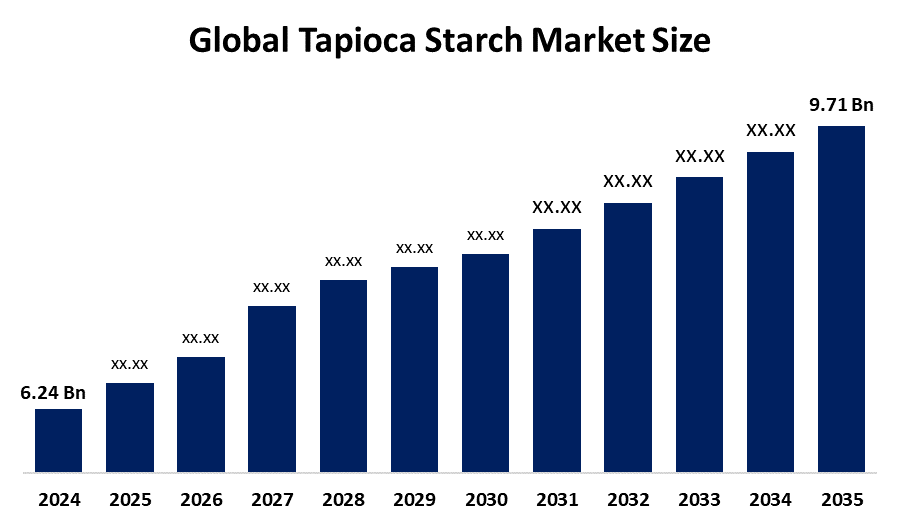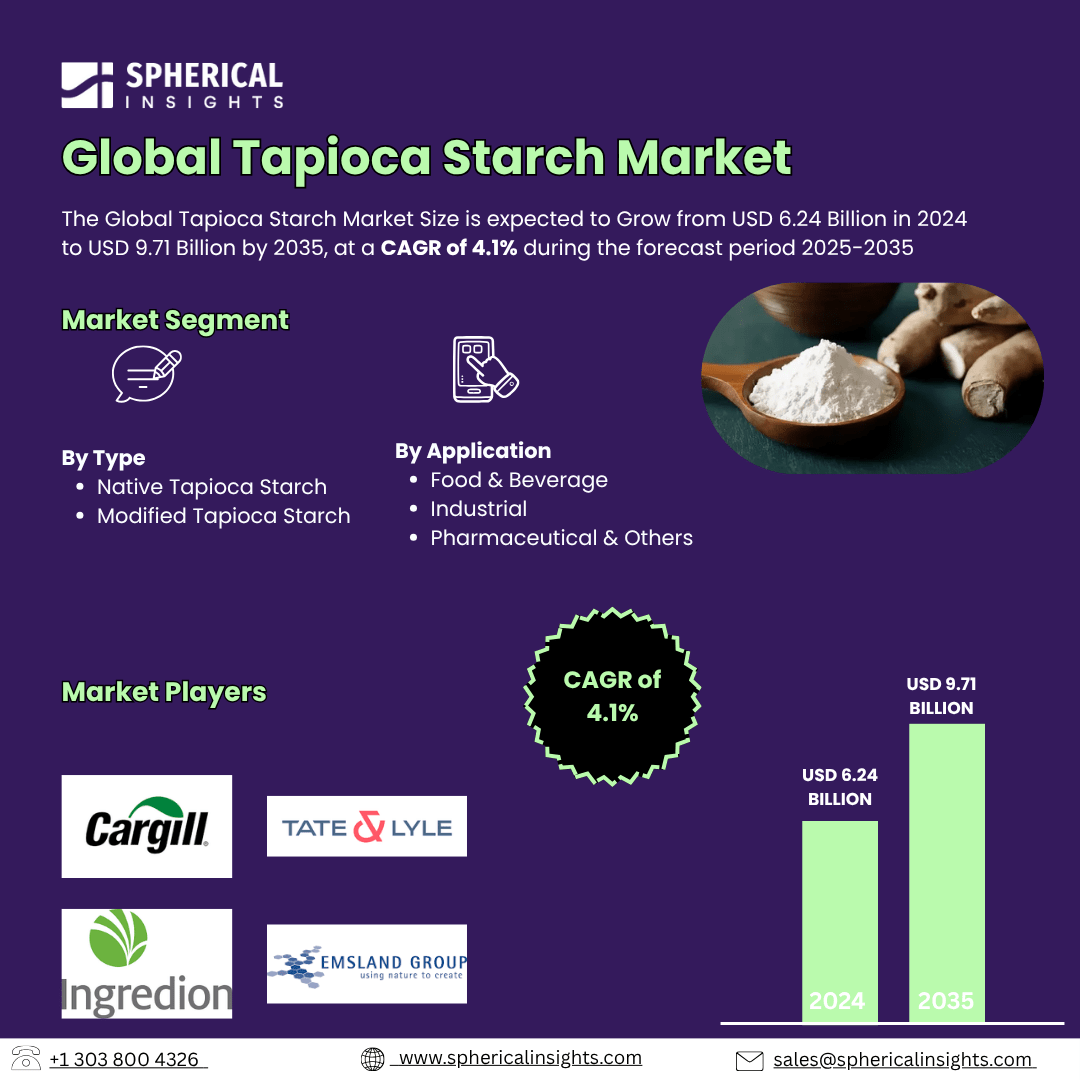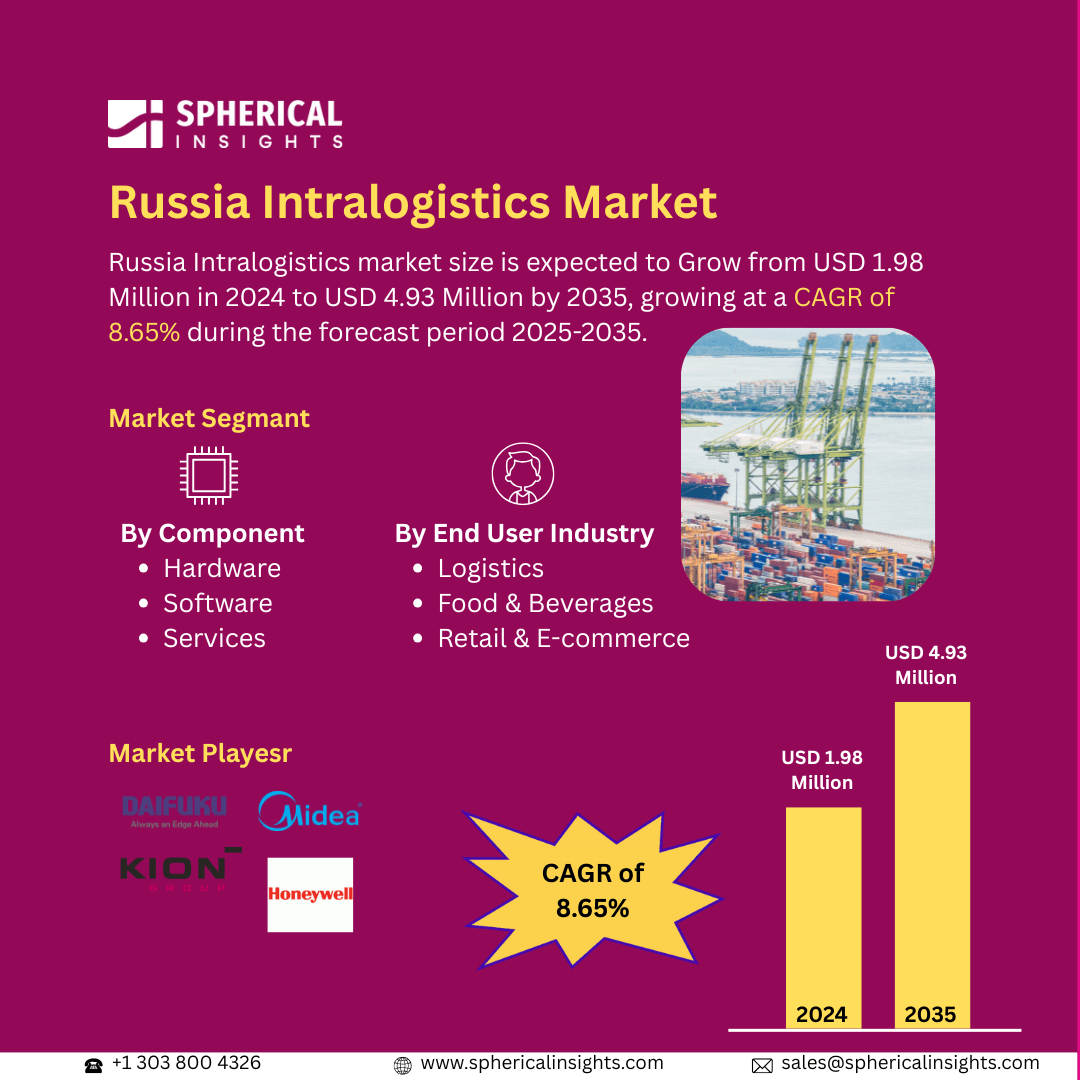Tapioca Starch Market Summary, Size & Emerging Trends
According to Decision Advisor, The Global Tapioca Starch Market Size is expected to Grow from USD 6.24 Billion in 2024 to USD 9.71 Billion by 2035, at a CAGR of 4.1% during the forecast period 2025-2035. Increasing demand for clean-label, gluten-free, and functional ingredients in the food and beverage industry is a key driving factor for the tapioca starch market.
Key Market Insights
- Asia Pacific is expected to account for the largest share in the tapioca starch market during the forecast period.
- In terms of type, the native tapioca starch segment dominated in terms of revenue during the forecast period.
- In terms of application, the food & beverage segment accounted for the largest revenue share in the global tapioca starch market during the forecast period.
Global Market Forecast and Revenue Outlook
- 2024 Market Size: USD 6.24 Billion
- 2035 Projected Market Size: USD 9.71 Billion
- CAGR (2025-2035): 4.1%
- Asia Pacific: Largest market in 2024
- North America: Fastest growing market

Tapioca Starch Market
The Tapioca Starch Market Size revolves around producing starch from cassava roots, valued for its gluten-free, neutral, and versatile properties. Widely used as a thickener, stabilizer, and gelling agent, it serves diverse industries. In the food & beverage sector, it enhances bakery, confectionery, and dairy products, while industrial applications include textiles, paper, and adhesives. The pharmaceutical and other specialty sectors also use tapioca starch for formulation and functional purposes. Key producing countries support the market through agricultural initiatives, subsidies, and research to improve cassava yield and starch quality. Increasing consumer preference for clean-label, natural, and plant-based ingredients drives global demand. Technological advancements in modified starches further expand its applications. Overall, tapioca starch is a multifunctional, sustainable ingredient experiencing steady growth due to rising industrial, food, and health-focused adoption worldwide.
Tapioca Starch Market Trends
- Growing demand for gluten-free, clean-label, and functional food ingredients is boosting tapioca starch consumption.
- Technological advancements are enabling the production of modified tapioca starches with enhanced properties like freeze-thaw stability, viscosity control, and fat mimicking.
- Companies are forming strategic partnerships and collaborations to expand product portfolios and strengthen global distribution networks.
Tapioca Starch Market Dynamics
Driving Factors: Rising demand from food & beverage and industrial sectors
The tapioca starch market is primarily driven by growing demand in the food & beverage industry, where it is widely used in bakery, confectionery, and dairy products due to its excellent thickening, stabilizing, and gelling properties. Additionally, industrial applications in textiles, adhesives, and paper manufacturing contribute significantly to market growth. Government initiatives supporting cassava cultivation, such as subsidies and research funding, enhance production capabilities and ensure raw material availability. Furthermore, increasing consumer preference for gluten-free, natural, and clean-label ingredients reinforces the adoption of tapioca starch in both food and industrial applications, strengthening market expansion globally.
Restrain Factors: Availability of alternative starches and price fluctuations
The market faces restraints from competition with alternative starches such as corn, potato, and wheat starch, which are widely available and sometimes preferred for cost reasons. Additionally, fluctuating cassava raw material prices and adverse climatic conditions can disrupt supply and increase production costs. Compliance with stringent food safety and quality regulations further raises operational expenses, particularly in regions with strict regulatory frameworks, which may limit market growth and adoption in certain areas.
Opportunity: Rising demand for modified starches and functional ingredients
Opportunities are emerging in the development of modified tapioca starches with enhanced functionalities tailored for industrial, pharmaceutical, and food applications. Rising consumer trends for plant-based, gluten-free, and clean-label products open new avenues for innovation and adoption. Moreover, emerging economies experiencing rapid growth in food processing and industrial sectors provide untapped potential for tapioca starch producers to expand their footprint and introduce value-added starch products.
Challenges: Supply chain volatility and climate dependency
The market faces challenges due to climatic dependency, as cassava cultivation is sensitive to weather fluctuations, impacting starch availability. Supply chain disruptions and price volatility can affect consistent production and profitability. Additionally, adoption barriers exist in regions where consumers or industries prefer traditional starches, limiting market penetration. Overcoming these challenges requires investment in supply chain resilience, awareness programs, and technological innovation in starch processing.
Global Tapioca Starch Market Ecosystem Analysis
The global tapioca starch market ecosystem comprises cassava growers, starch manufacturers, distributors, and end-users across food, industrial, and pharmaceutical sectors. Suppliers play a key role in raw material availability and pricing, while manufacturers focus on innovation, quality, and developing modified starches for specialized applications. Distributors ensure timely delivery to various industries, and regulatory bodies enforce food safety, quality, and environmental standards. Market growth depends on efficient supply chains, adoption of advanced production technologies, and adherence to regulations, enabling sustainable expansion and meeting rising demand for versatile, clean-label starch products globally.
Global Tapioca Starch Market, By Type
What key advantages helped the native tapioca starch segment outperform others in the market?
The native tapioca starch segment holds the largest revenue share, approximately 65% of the tapioca starch market, due to its natural composition, cost-effectiveness, and wide-ranging industrial applications. Native tapioca starch is derived directly from cassava roots without chemical modification, making it highly suitable for food, beverage, and industrial uses where natural ingredients are preferred. Its affordability compared to modified starches makes it attractive to manufacturers seeking efficient production solutions. Additionally, native tapioca starch exhibits excellent thickening, gelling, and binding properties, which enhance its versatility across various sectors, including confectionery, bakery, and textiles.

How is the modified tapioca starch segment achieving rapid market growth?
The modified tapioca starch segment accounts for approximately 35% of the global tapioca starch market and is experiencing rapid growth due to its enhanced functional properties and adaptability for specialized applications. Unlike native starch, modified tapioca starch undergoes physical, chemical, or enzymatic treatment to improve its stability, thickening, gelling, and freeze-thaw resistance, making it ideal for the food, pharmaceutical, and industrial sectors. Its ability to meet specific processing requirements and withstand harsh conditions gives manufacturers greater flexibility in product formulation. Additionally, the rising demand for convenience foods, processed products, and industrial applications is driving adoption of modified starches at an accelerated pace.
Global Tapioca Starch Market, By Application
Why was the food & beverage industry the primary consumer of tapioca starch?
The food & beverage segment holds the largest revenue share in the tapioca starch market, approximately 50%, due to its extensive use in a wide variety of products and its functional versatility. Tapioca starch is widely employed in bakery items, confectionery, sauces, dairy products, and snacks as a thickening, gelling, and stabilizing agent, which makes it highly valuable for manufacturers seeking consistent quality and performance. Its neutral taste, hypoallergenic properties, and gluten-free nature further enhance its appeal in food applications, especially amid growing consumer demand for health-conscious and specialty products.
What made the industrial segment a key consumer of tapioca starch?
The industrial segment accounts for a significant share of around 30% of the tapioca starch market due to its diverse applications across various industries and the functional benefits of starch. Industrial users leverage tapioca starch in textiles, paper, adhesives, biodegradable films, and packaging materials for its excellent binding, thickening, and film-forming properties. Its cost-effectiveness, renewability, and environmentally friendly characteristics make it especially attractive for sustainable manufacturing processes. Additionally, tapioca starch’s consistent quality and adaptability allow industrial manufacturers to optimize production and meet specific process requirements.
Asia Pacific region commands the largest share, approximately 45%, largely due to the presence of major cassava-producing countries like Thailand, Vietnam, and Indonesia. These countries have well-established cassava cultivation and starch processing industries, supported by favorable climatic conditions, advanced farming practices, and government initiatives promoting cassava production. The region benefits from high domestic consumption in food & beverage and industrial applications, along with a growing export market for tapioca starch. Rising awareness about gluten-free, clean-label, and plant-based ingredients also boosts demand in emerging urban markets. Investment in modern processing technologies and sustainable practices further strengthens Asia Pacific’s dominance.
India is experiencing rapid growth at a CAGR of 10%, driven by rising industrial demand from the food processing, pharmaceutical, and adhesive sectors. Government support for cassava farming, including subsidies, technical guidance, and research initiatives, is improving yields and quality. Rapid urbanization and industrialization are increasing the need for tapioca starch in both domestic consumption and export markets. Additionally, the growing trend for gluten-free and natural ingredients in food products is accelerating adoption across bakery, dairy, and snack segments.
North America is the fastest-growing market with a CAGR of 18%, spurred by increasing consumer preference for gluten-free, clean-label, and plant-based foods, particularly in the United States and Canada. Industrial adoption in adhesives, pharmaceuticals, textiles, and paper products also drives growth. Technological advancements in starch modification, supportive regulatory frameworks for food safety and labeling, and growing awareness of sustainable and eco-friendly products contribute to accelerated market expansion. Moreover, the rise in processed and convenience food consumption adds significant momentum to the tapioca starch market.
WORLDWIDE TOP KEY PLAYERS IN THE TAPIOCA STARCH MARKET INCLUDE
- Cargill, Incorporated
- Ingredion Incorporated
- Tate & Lyle PLC
- Emsland Group
- Roquette Frères
- AVEBE
- PT Indofood Sukses Makmur Tbk
- Thai Tapioca Starch Co., Ltd.
- Changshu Hongsheng Starch Co., Ltd.
- Other regional manufacturers
- Others
Product Launches in Tapioca Starch Market
- In March 2024, Ingredion introduced a new line of modified tapioca starch designed to provide enhanced freeze-thaw stability, specifically catering to frozen and refrigerated food applications. This innovation improves the texture, consistency, and shelf-life of products like bakery goods, dairy items, and ready-to-eat meals. The launch addresses growing consumer demand for convenient, high-quality, and stable food products, while also supporting manufacturers with a versatile ingredient that performs reliably under industrial processing conditions. Globally, this product strengthens Ingredion’s position in the functional starch market, aligning with trends in plant-based, gluten-free, and clean-label foods.
Market Segment
This study forecasts revenue at global, regional, and country levels from 2020 to 2035. Decision Advisor has segmented the Tapioca Starch market based on the below-mentioned segments:
Global Tapioca Starch Market, By Type
- Native Tapioca Starch
- Modified Tapioca Starch
Global Tapioca Starch Market, By Application
- Food & Beverage
- Industrial
- Pharmaceutical & Others
Global Tapioca Starch Market, By Regional Analysis
- North America
- Europe
- Germany
- UK
- France
- Italy
- Spain
- Russia
- Rest of Europe
- Asia Pacific
- China
- Japan
- India
- South Korea
- Australia
- Rest of Asia Pacific
- South America
- Brazil
- Argentina
- Rest of South America
- Middle East & Africa
- UAE
- Saudi Arabia
- Qatar
- South Africa
- Rest of the Middle East & Africa
FAQs
Q: What opportunities exist in the tapioca starch market?
A: Opportunities include the rising demand for modified starches with specialized functionalities, increasing adoption in plant-based and gluten-free products, and growth in emerging economies.
Q: What challenges does the tapioca starch market face?
A: Challenges include climate dependency affecting cassava yield, supply chain volatility, and regional preferences for traditional starches limiting market penetration.
Q: Who are the top key players in the Global Tapioca Starch Market?
A: Key players include Cargill, Incorporated, Ingredion Incorporated, Tate & Lyle PLC, Emsland Group, Roquette Frères, AVEBE, PT Indofood Sukses Makmur Tbk, Thai Tapioca Starch Co., Ltd., Changshu Hongsheng Starch Co., Ltd., and other regional manufacturers.
Q: What are the latest product innovations in the tapioca starch market?
A: In March 2024, Ingredion launched a line of modified tapioca starch with enhanced freeze-thaw stability for frozen and refrigerated foods, supporting plant-based, gluten-free, and clean-label trends.
Q: How is India performing in the tapioca starch market?
A: India is growing rapidly at a CAGR of 10%, driven by rising industrial demand from food processing, pharmaceutical, and adhesive sectors, along with government support for cassava cultivation.
Q: What trends are emerging in the tapioca starch market?
A: Key trends include growing demand for gluten-free and clean-label ingredients, development of modified starches with enhanced functional properties, and strategic partnerships for expanding global distribution networks.
Q: What is the long-term outlook (2025–2035) for the tapioca starch market?
A: The market is expected to maintain steady growth, driven by rising food & beverage and industrial demand, technological advancements in starch modification, and increasing global adoption of natural, plant-based ingredients.





